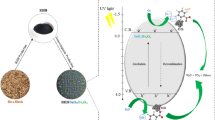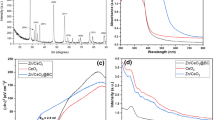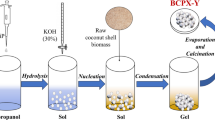Abstract
Acid pretreated biomass Lemna minor (BM-H3PO4) was used as support for CuO nanoparticles loading, to investigate the dye biosorption capacity and the photocatalytic performance under artificial visible light. The surface morphology, crystal structure, elemental composition, and the bandgap of modified biomass have been determined using FE-SEM, XRD, EDX, XPS, FTIR, and UV-DR analysis. The results showed that NH2 and P-O functional groups of (BM-H3PO4) can attract the copper ions (Cu2+), which can facilitate the loading of CuO nanoparticles hence, smaller nanoparticles with an average diameter of 21 nm was obtained. It was also found that when the CuO was incorporated in BM-H3PO4 in a proper mass ratio of 0.4, the biosorption efficiency was enhanced to 3 times compared with BM-H3PO4 and reached a maximum of 91%, at a dye concentration of 20 mg/L, solution pH equal to 5, and an ambient temperature of 25 °C. Furthermore, CuO-modified BM-H3PO4 exhibits a better photocatalytic activity than pure CuO in the presence of H2O2 and visible light irradiation, where the dye was completely removed and mineralized after 240 min, evidenced by COD measurement. The photocatalytic regeneration also shows that the biosorption efficiency was maintained at 91% over 3 cycles, indicating the significant self-regenerative capacity of the biosorbent.













Similar content being viewed by others
References
Aghaei M, Sajjadi S, Keihan AH (2020) Sono-coprecipitation synthesis of ZnO / CuO nanophotocatalyst for removal of parathion from wastewater. Ultrason Sonochem 40:323–332
Albay C, Koc M, Altin I, Bayrak R, Degirmencioglu I, Sokmen M (2016) New dye sensitized photocatalysts: Copper(II)-phthalocyanine/TiO2 nanocomposite for water remediation Journal of Photochemistry and Photobiology A: Chemistry. 15: 1010-6030. https://doi.org/10.1016/j.jphotochem.2016.03.024.
Anjaneyulu RB, Mohan BS, Naidu GP (2018) Visible light enhanced photocatalytic degradation of methylene blue by ternary nanocomposite , MoO 3 / Fe 2 O 3 / rGO. J Asian Ceram Soc 6:183–195. https://doi.org/10.1080/21870764.2018.1479011
Anwer H, Mahmood A, Lee J, Kim KH, Park JW, Yip ACK (2019) Photocatalysts for degradation of dyes in industrial effluents: opportunities and challenges. Nano Res 12(5):955–972. https://doi.org/10.1007/s12274-019-2287-0
Asfaram A, Ghaedi M, Dashtian K, Ghezelbash GR (2018) Preparation and characterization of Mn0.4Zn0.6Fe2O4 nanoparticles supported on dead cells of Yarrowia lipolytica as a novel and efficient adsorbent/biosorbent composite for the removal of azo food dyes: central composite design optimization study. ACS Sustain Chem Eng 6:4549–4563. https://doi.org/10.1021/acssuschemeng.7b03205
Bajaj R, Sharma M, Bahadur D (2013) Visible light-driven novel nanocomposite (BiVO4/CuCr2O4) for efficient degradation of organic dye. Dalton Trans 42(19):6736–6744. https://doi.org/10.1039/c2dt32753h
Basu M, Sinha K, Pradhan M, Sarkar S (2010) Monoclinic CuO nanoflowers on resin support: recyclable catalyst to obtain perylene compound. Chem Commun 2:8785–8787. https://doi.org/10.1039/c0cc03137b
Binas V, Venieri D, Kotzias D, Kiriakidis G (2017) Modified TiO 2 based photocatalysts for improved air and health quality. J Mater 3(1):3–16. https://doi.org/10.1016/j.jmat.2016.11.002
Biobr P (2015) imulated sunlight photocatalytic degradation of aqueous p-nitrophenol and bisphenol A in a Pt/BiOBr film-coated quartz fiber photoreactor. Dalton Trans 44(20):9439–9449. https://doi.org/10.1039/c5dt00417a
Bissessur R, Liu PKY, Scully SF (2006) Intercalation of polypyrrole into graphite oxide. Synth Met 156:1023–1027. https://doi.org/10.1016/j.synthmet.2006.06.024
Bokare AD, Chikate RC, Rode CV, Paknikar KM (2008) Iron-nickel bimetallic nanoparticles for reductive degradation of azo dye Orange G in aqueous solution. Appl Catal B Environ 79:270–278. https://doi.org/10.1016/j.apcatb.2007.10.033
Chen F, Liu Z, Liu Y, Fang P, Dai Y (2013) Enhanced adsorption and photocatalytic degradation of high-concen- tration methylene blue on Ag 2 O-modified TiO 2 -based nanosheet. Chem Eng J 221:283–291. https://doi.org/10.1016/j.cej.2013.02.019
Chowdhury S, Chakraborty S, Saha PD (2013) Response surface optimization of a dynamic dye adsorption process: a case study of crystal violet adsorption onto NaOH-modified rice husk. Environ Sci Pollut Res 20(3):1698–1705. https://doi.org/10.1007/s11356-012-0989-7
Davaritouchaee M, Hiscox WC, Martinez-fernandez J, Fu X, Mancini RJ, Chen S (2019) Industrial Crops & Products Effect of reactive oxygen species on biomass structure in di ff erent oxidative processes. Ind Crop Prod 137:484–494. https://doi.org/10.1016/j.indcrop.2019.05.063
Debnath S, Ballav N, Nyoni H, Maity A, Pillay K (2015) Optimization and mechanism elucidation of the catalytic photo-degradation of the dyes Eosin Yellow (EY) and Naphthol blue black (NBB) by a polyaniline-coated titanium dioxide nanocomposite. Appl Catal B Environ 163:330–342. https://doi.org/10.1016/j.apcatb.2014.08.011
Ding J, Liu L, Xue J, Zhou Z, He G, Chen H (2016) AC SC. Low-temperature preparation of magnetically separable Fe 3 O 4 @CuO-RGO core-shell heterojunctions for high-performance removal of organic dye under visible light. J Alloys Compd 688:649–656. https://doi.org/10.1016/j.jallcom.2016.07.001
Elgarahy AM, Elwakeel KZ, Elshoubaky GA, Mohammad SH (2019) Untapped sepia shell–based composite for the sorption of cationic and anionic dyes. Water Air Soil Pollut 230-217. https://doi.org/10.1007/s11270-019-4247-1.
Farouk HU, Raman A, Daud WMAW (2015) TiO2 catalyst deactivation in textile wastewater treatment: current challenges and future advances. J Ind Eng Chem 33:11–21. https://doi.org/10.1016/j.jiec.2015.10.022
Fu C, Juang R, Mahmudul M, Hsieh C (2016) Enhanced adsorption and photodegradation of phenol in aqueous suspensions of titania / graphene oxide composite catalysts Journal of the Taiwan Institute of Chemical Engineers 1–8. https://doi.org/10.1016/j.jtice.2016.07.043.
Ge H, Wang C, Liu S, Huang Z (2016) Synthesis of citric acid functionalized magnetic graphene oxide coated corn straw for methylene blue adsorption. Bioresour Technol 221:419–429. https://doi.org/10.1016/j.biortech.2016.09.060
George G, Saravanakumar MP (2018) Correction to: Facile synthesis of carbon-coated layered double hydroxide and its comparative characterisation with Zn – Al LDH: application on crystal violet and malachite green dye adsorption — isotherm , kinetics and Box-Behnken design. Environ Sci Pollut Res 25(30):30255–30256. https://doi.org/10.1007/s11356-018-3115-7
Gomes J, Lincho J, Domingues E, Quinta-Ferreira R, Martins R (2019) N–TiO2 Photocatalysts: a review of their characteristics and capacity for emerging contaminants removal. Water 11(2):373. https://doi.org/10.3390/w11020373
Guo J, Wang J, Zheng G, Jiang X (2019) RESEARCH ARTICLE A TiO 2 / crosslinked carboxymethyl starch composite for high-efficiency adsorption and photodegradation of cationic golden yellow X-GL dye. Environ Sci Pollut Res 26(24):24395–24406. https://doi.org/10.1007/s11356-019-05685-y
Halder M, Ansari Z, Ahammed S, Sen K (2017) Biogenic nano-CuO-catalyzed facile C − N cross-coupling reactions: scope and mechanism. ACS Sustain Chem Eng 5(1):648–657. https://doi.org/10.1021/acssuschemeng.6b02013
Han F, Yang S, Jing W, Jiang K, Jiang Z, Liu H, Li L (2014) Surface plasmon enhanced photoluminescence of ZnO nanorods by capping reduced graphene oxide sheets. Opt Express 22(10):11436–11445. https://doi.org/10.1364/oe.22.011436
Hou Y, Wen Z, Cui S, Guo X, Chen J (2013) Constructing 2D porous graphitic C3N4 nanosheets/nitrogen-doped graphene/layered MoS2 ternary nanojunction with enhanced photoelectrochemical activity. Adv Mater 25:6291–6297. https://doi.org/10.1002/adma.201303116
Hsini A, Essekri A, Aarab N, Laabd M (2020) Elaboration of novel polyaniline @ Almond shell biocomposite for effective removal of hexavalent chromium ions and Orange G dye from aqueous solutions. Environement Science Pollution Research.
Huang R (2017) Adsorption of methyl orange onto protonated cross-linked chitosan. Arab J Chem 10(1):24–32. https://doi.org/10.1016/j.arabjc.2013.05.017
Jamshidi M, Ghaedi M, Dashtian K, Hajati S (2015) mesoporous SBA-15 for selective separation and preconcentration of Cr ( III ) ions: modeling and optimization. RSC Adv 5:105789–105799. https://doi.org/10.1039/C5RA17873H
Jönsson LJ, Martín C (2015) Bioresource technology pretreatment of lignocellulose: formation of inhibitory by-products and strategies for minimizing their effects. Bioresour Technol 199:103–112. https://doi.org/10.1016/j.biortech.215.10.009
Kanan MW, Nocera DG (2008) In situ formation of an oxygen-evolving catalyst in neutral water containing phosphate and Co2+. Science 321(5892):1072–1075. https://doi.org/10.1126/science.1162018
Kasiri MB, Aleboyeh H, Aleboyeh A (2008) Environmental degradation of acid blue 74 using Fe-ZSM5 zeolite as a heterogeneous photo-Fenton catalyst. Applied Catalysis B 84:9–15. https://doi.org/10.1016/j.apcatb.2008.02.024
Kumar A, Rout L, Achary LSK, Mohanty SK, Dash P (2017) A combustion synthesis route for magnetically separable graphene oxide-CuFe2O4-ZnO nanocomposites with enhanced solar light-mediated photocatalytic activity. New J Chem 41:10568–10583. https://doi.org/10.1039/c7nj02070h
Kyzas GZ, Bikiaris DN (2015) Recent modifications of chitosan for adsorption applications: a critical and systematic review. Marine Drugs 13(1):312–337. https://doi.org/10.3390/md13010312
Li J, Ren Y, Ji F, Lai B (2017) Heterogeneous catalytic oxidation for the degradation of p-nitrophenol in aqueous solution by persulfate activated with CuFe2O4 magnetic nano-particles. Chem Eng J 324:63–73. https://doi.org/10.1016/j.cej.2017.04.104
Li Y, Xu M, Pan L, Zhang Y, Guo Z, Bi C (2010) Structural and room-temperature ferromagnetic properties of Fe-doped CuO nanocrystals. J Appl Phys 107(11):113–908. https://doi.org/10.1063/1.3436573
Liao G, Chen S, Quan X, Yu H, Zhao H (2012) Graphene oxide modified g-C 3N 4 hybrid with enhanced photocatalytic capability under visible light irradiation. J Mater Chem 22:2721–2726. https://doi.org/10.1039/c1jm13490f
Lin Q, Gao M, Chang J, Ma H (2016) Adsorption properties of crosslinking carboxymethyl cellulose grafting dimethyldiallylammonium chloride for cationic and anionic dyes. Carbohydr Polym 151:283–294. https://doi.org/10.1016/j.carbpol.2016.05.064
Links DA (2011) Facile synthesis of rhombic dodecahedral AgX / Ag 3 PO 4 ( X = Cl , Br , I ) heterocrystals with enhanced photocatalytic properties and stabilities. Phys Chem Chem Phys 13(21):10071–10075. https://doi.org/10.1039/c1cp20488b
Liu L, Gao Z, Su X et al (2015) Adsorption removal of dyes from single and binary solutions using a cellulose-based bioadsorbent adsorption removal of dyes from single and binary solutions using a cellulose-based bioadsorbent. ACS Sustain Chem Eng 3(3):432–442. https://doi.org/10.1021/sc500848m
Massadeh AM, Massadeh HA (2019) Uptake of Cd and Pb from aqueous solutions using selected tree leaves through phytoremediation water. Air. Soil Pollut. 230 (9). https://doi.org/10.1007/s11270-019-4273-z.
Marques BS, Frantz TS, Sant’Anna Cadaval Junior TR, Almeida TRP, Dotto LA (2019) Adsorption of a textile dye onto piaçava fibers: kinetic, equilibrium, thermodynamics, and application in simulated effluents. Environ Sci Pollut Res 26:28584–28592. https://doi.org/10.1007/s11356-018-3587-5
Matias CA, Vilela PB, Becegato VA, Paulino AT (2019) Adsorption kinetic , isotherm and thermodynamic of 2 , 4-dichlorophenoxyacetic acid herbicide in novel alternative natural adsorbents. Water Air Soil Pollut 230(12):1–13
Mendonça ARV, Zanardi GB, Brum SS, de Campos TA, Cardoso CMM, Zavarize DG (2019) RR2 dye adsorption to Hymenaea courbaril L. bark activated carbon associated with biofilm. Environ Sci Pollut Res 26:28524–28532. https://doi.org/10.1007/s11356-018-3786-0
Minitha CR, Lalitha M, Jeyachandran YL (2017) Adsorption behaviour of reduced graphene oxide towards cationic and anionic dyes: Co-action of electrostatic and π – π interactions. Mater Chem Phys 194:243–252. https://doi.org/10.1016/j.matchemphys.2017.03.048
Moussa H, Girot E, Mozet K, Alem H, Medjahdi G (2016) ZnO rods/reduced graphene oxide composites prepared via a solvothermal reaction for efficient sunlight-driven photocatalysis. Appl Catal B Environ 185:11–21. https://doi.org/10.1016/j.apcatb.2015.12.007
Nair VR, Kodialbail VS (2020) Floating bed reactor for visible light induced photocatalytic degradation of Acid Yellow 17 using polyaniline-TiO 2 nanocomposites immobilized on polystyrene cubes. Environ Sci Pollut Res 27:14441–14453. https://doi.org/10.1007/s11356-020-07959-2
Nishiyama Y, Sugiyama J, Chanzy H, Langan P (2003) Crystal structure and hydrogen bonding system in cellulose Iα from synchrotron X-ray and neutron fiber diffraction. J Am Chem Soc 125:14300–14306. https://doi.org/10.1021/ja037055w
Omar FS, Nay Ming H, Hafiz SM, Ngee LH (2014) Microwave synthesis of zinc oxide/reduced graphene oxide hybrid for adsorption-photocatalysis application. Int J Photoenergy 1-8. https://doi.org/10.1155/2014/176835
Ong CB, Mohammad AW, Ng LY (2018) Integrated adsorption-solar photocatalytic membrane reactor for degradation of hazardous Congo red using Fe-doped ZnO and Fe-doped ZnO / rGO nanocomposites. Environ Sci Pollut Res 26(33):33856–33869. https://doi.org/10.1007/s11356-018-2557-2
Petit C, Kante K, Bandosz TJ (2010) The role of sulfur-containing groups in ammonia retention on activated carbons. Carbon NY 48:654–667. https://doi.org/10.1016/j.carbon.2009.10.007
Po A, Particles S (2012) Visible-light photocatalytic activity and deactivation mechanism of Ag 3 PO 4 spherical particles. 1–8. https://doi.org/10.1002/asia.201200197.
Puziy AM, Poddubnaya OI, Socha RP, Gurgul J, Wisniewski M (2008) XPS and NMR studies of phosphoric acid activated carbons. Carbon NY 46: 2113–2123. https://doi.org/10.1016/j.carbon.2008.09.010.
Reddy KO, Uma Maheswari CU, Shukla M, Song JI, Rajulu AV (2013) Tensile and structural characterization of alkali treated Borassus fruit fine fibers Compos. Part B Eng 44:433–438. https://doi.org/10.1016/j.compositesb.2012.04.075
Rezania S, Mat S, Fadhil M (2016) Comprehensive review on phytotechnology: heavy metals removal by diverse aquatic plants species from wastewater. J Hazard Mater 318:587–599. https://doi.org/10.1016/j.jhazmat.2016.07.053
Saison T, Chemin N, Chane C, Durupthy O, Mariey L, Maugé F, Jolivet JP (2015) New insights into BiVO 4 properties as visible light photocatalyst. J Phys Chem C 119(23):12967–12977. https://doi.org/10.1021/acs.jpcc.5b01468
Santos DO, De Lourdes M, Santos N, Costa JAS, Jesus RA, Navickiene S, Sussuchi EM, Mesquita ME (2013) Investigating the potential of functionalized MCM-41 on adsorption of Remazol Red dye. Environ Sci Pollut Res 20(7):5028–5035. https://doi.org/10.1007/s11356-012-1346-6
Saravanan R, Karthikeyan S, Gupta VK, Sekaran G, Narayanan V, Stephen A (2013) Enhanced photocatalytic activity of ZnO / CuO nanocomposite for the degradation of textile dye on visible light illumination. Mater Sci Eng C 33:91–98. https://doi.org/10.1016/j.msec.2012.08.011
Sen XY, Zhang DW (2013) Morphology-controlled synthesis of Ag3PO4 microcrystals for high performance photocatalysis. Cryst Eng Comm 15:5407–5411. https://doi.org/10.1039/c3ce40172c
Selvaraj M, Venkatachalapathy V, Mayandi J, Karazhanov S, Pearce JM (2015) Preparation of meta-stable phases of barium titanate by Sol-hydrothermal method. AIP Adv 5(11):117–119. https://doi.org/10.1063/1.4935645
Sheintuch M, Matatov-meytal YI (1999) Comparison of catalytic processes with other regeneration methods of activated carbon. Catal Today 53:73–80
Singh V, Suri S, Bamzai KK (2013) Mechanical behaviour and fracture mechanics of praseodymium modified lead titanate ceramics prepared by solid-state reaction route mechanical behaviour and fracture mechanics of praseodymium modified lead titanate ceramics prepared by solid-state reaction route. Journal of Ceramics 1–9. doi:https://doi.org/10.1155/2013/280605.
Stephen A, Dhanavela S, Nivethaaa EAK, Dhanapala K, Gupta VK, Narayanand V (2016) α- MoO3/polyaniline composite for effective scavenging of rhodamine B, Congo red and textile dye effluent. RSC Adv 6:28871–28886
Son Y, Hong J, Lim H, Kim T (2005) A study of heterobifunctional reactive dyes on nylon fibers : dyeing properties , dye moiety analysis and wash fastness. Dyes Pigments 66:231–239. https://doi.org/10.1016/j.dyepig.2004.10.004
Sun D, Zhang Z, Wang M, Wu Y (2013) Adsorption of reactive dyes on activated carbon developed from Enteromorpha prolifera. Am J Anal Chem 04(07):17–26
Tang H, Chang S, Jiang L, Tang G, Liang W (2016) Novel spindle-shaped nanoporous TiO2 coupled graphitic g-C3N4 nanosheets with enhanced visible-light photocatalytic activity. Ceram Int 42:18443–18452. https://doi.org/10.1016/j.ceramint.2016.08.179
Titelman GI, Gelman V, Bron S, Khalfin RL, Cohen Y, Bianco PH (2005) Characteristics and microstructure of aqueous colloidal dispersions of graphite oxide. Carbon N Y 43:641–649. https://doi.org/10.1016/j.carbon.2004.10.035
Turk M, Boskovic N, Slavkovic A, Garunovic J, Kolakovic S, Pap S (2019) Surface functionalised adsorbent for emerging pharmaceutical removal: adsorption performance and mechanisms. Process Saf Environ Prot 125:50–63. https://doi.org/10.1016/j.psep.2019.03.007
Vimonses V, Jin B, Chow CWK, Saint C (2010) An adsorption e photocatalysis hybrid process using multi-functional-nanoporous materials for wastewater reclamation. Water Res 44:5385–5397. https://doi.org/10.1016/j.watres.2010.06.033
Wahab R, Khan F, Kaushik NK, Musarrat J, Al-Khedhairy AA (2017) Photocatalytic TMO-NMs adsorbent: temperature-time dependent safranine degradation , sorption study validated under optimized effective equilibrium models parameter with standardized statistical analysis. Sci Rep 7(1). https://doi.org/10.1038/srep42509
Wan W, Yu S, Dong F, Zhang Q, Zhou Y (2016) Efficient C3N4/graphene oxide macroscopic aerogel visible-light photocatalyst. J Mater Chem A Mater energy Sustain 4:7823–7829. https://doi.org/10.1039/C6TA01804A
Wang H, Li D, Hong M, Dou J (2013) Syntheses , structural characterization and in vitro cytotoxic activity of triorganotin ( IV ) complexes based on 1 , 7-dihydroxycarbonyl-1 , 7-dicarba-closo- dodecaborane ligand. J Organomet Chem 740:1–9. https://doi.org/10.1016/j.jorganchem.2013.04.039
Wang Y, Runnerstrom EL, Milliron DJ (2016) Switchable materials for Smart Windows. Annual Review of Chemical and Biomolecular Engineering 7(1):283–304. https://doi.org/10.1146/annurev-chembioeng-080615-034647
Wu L, Wan W, Shang Z, Gao X, Kobayashi N, Luo G, Li Z (2018) Surface modification of phosphoric acid activated carbon by using non-thermal plasma for enhancement of Cu(II) adsorption from aqueous solutions. Sep Purif Technol 197:156–169. https://doi.org/10.1016/j.seppur.2018.01.007
Xi T, Hong S, Xia F (2012) Green synthesis of CuO nano fl akes from CuCO 3 · Cu ( OH ) 2 powder and H 2 O 2 aqueous solution. Powder Technol 228:128–130. https://doi.org/10.1016/j.powtec.2012.05.007
Xiong W, Zeng Z, Li X, Zeng G, Xiao R, Yang Z, Zhou Y, Zhang C, Cheng M, Hu L, Zhou C, Qin L, Xu R, Zhang Y (2018) Multi-walled carbon nanotube/amino-functionalized MIL-53(Fe) composites: remarkable adsorptive removal of antibiotics from aqueous solutions. Chemosphere 210:1061–1069. https://doi.org/10.1016/j.chemosphere.2018.07.084
Xu S, Ng J, Zhang X, Bai H, Sun DD (2011) Colloids and surfaces A: physicochemical and engineering aspects adsorption and photocatalytic degradation of Acid Orange 7 over hydrothermally synthesized mesoporous TiO 2 nanotube. Colloids Surfaces A Physicochem Eng Asp 379:169–175. https://doi.org/10.1016/j.colsurfa.2010.11.032
Yadav V, Verma P, Sharma H, Tripathy S, Kumar VS (2020) Photodegradation of 4-nitrophenol over B-doped TiO 2 nanostructure: effect of dopant concentration, kinetics, and mechanism. Environ Sci Pollut Res 27(10):10966–10980. https://doi.org/10.1007/s11356-019-06674-x
Yan H, Wang X, Yao M, Yao X (2013) Band structure design of semiconductors for enhanced photocatalytic activity: the case of TiO2. Progress in Natural Science: Materials International 23(4):402–407. https://doi.org/10.1016/j.pnsc.2013.06.002
Yang C, Su X, Wang J, Cao X, Wang S, Zhang L (2013) Facile microwave-assisted hydrothermal synthesis of varied-shaped CuO nanoparticles and their gas sensing properties. Sensors Actuators B Chem 185:159–165. https://doi.org/10.1016/j.snb.2013.04.100
Yi H, Huang D, Zeng G, Lai C, Cheng M, Guo X (2018) SC Key Laboratory of Environmental Biology and Pollution Control Hunan. Appl Catal B Environ 239:408–424. https://doi.org/10.1016/j.apcatb.2018.07.068
Yi H, Zeng G, Lai C, Huang D, Tang L, Gong J (2017) Environment-friendly fullerene separation methods. Chem Eng J 330:134–145. https://doi.org/10.1016/j.cej.2017.07.143
Yu Y, Murthy BN, Shapter JG, Constantopoulos KT, Voelcker NH, Ellis AV (2013) Benzene carboxylic acid derivatized graphene oxide nanosheets on natural zeolites as effective adsorbents for cationic dye removal. J Hazard Mater 260:330–338. https://doi.org/10.1016/j.jhazmat.2013.05.041
Yuvaraj S, Karthikeyan K, Kalpana D, Lee YS, Selvan RK (2016) Surfactant-free hydrothermal synthesis of hierarchically structured spherical CuBi2O4 as negative electrodes for Li-ion hybrid capacitors. J Colloid Interface Sci 469:47–56. https://doi.org/10.1016/j.jcis.2016.01.060
Zhang Y, Xia K, Liu X, Chen Z, Du H, Zhang X (2019) Synthesis of cationic-modified silica gel and its adsorption properties for anionic dyes. J Taiwan Inst Chem Eng 102:1–8. https://doi.org/10.1016/j.jtice.2019.05.005
Zhou C, Zhao Y, Shang L, Shi R, Wu L, Tung C, Zhang T (2013) Facile synthesis of ultrathin SnNb2O6nanosheets towards improved visible-light photocatalytic H2-production activity. ChemComm 1-3. https://doi.org/10.1039/C6CC03739A.
Acknowledgments
The authors wish to express their gratitude to the national school of mines for FE-SEM and EDAX analysis service and S.T.E.P of Annaba for their help in COD measurement.
Author information
Authors and Affiliations
Corresponding author
Additional information
Responsible Editor: Santiago V. Luis
Publisher’s note
Springer Nature remains neutral with regard to jurisdictional claims in published maps and institutional affiliations.
Rights and permissions
About this article
Cite this article
Khaled, B., Nassira, Z. & Imene, H. Eco-friendly synthesis of self-regenerative low-cost biosorbent by the incorporation of CuO: a photocatalyst sensitive to visible light irradiation for azo dye removal. Environ Sci Pollut Res 27, 31074–31091 (2020). https://doi.org/10.1007/s11356-020-09364-1
Received:
Accepted:
Published:
Issue Date:
DOI: https://doi.org/10.1007/s11356-020-09364-1




